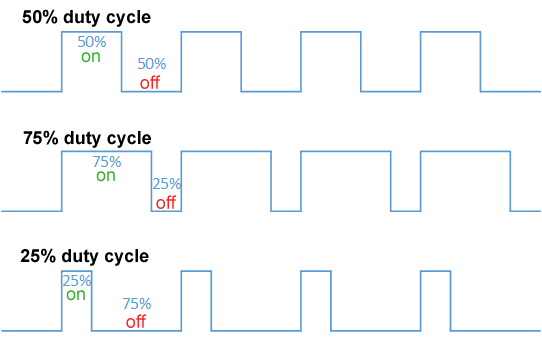Analog?
Sadly, the real world is very much analog. How does a MCU interface with such analog devices?
Pulse Width Modulation
Leveraging a concept known as Pulse Width Modulation or PWM. By turning a digital line on and off, the average voltage perceived at the end of the line changes. Using this, voltages between 0V and 5V can be achieved!
Generating a sine-wave from a digital signal using PWM:

PWM waveforms have 2 important characteristics:
- the frequency of the waveform
- the duty cycle
Frequency, just like in any periodic waveform, is the rate at which the wave repeats itself. A PWM signal running at 1 Hz will repeat itself every second.
Duty cycle is percentage of time the signal stays 'high' in a single period.
An example from Wikipedia:

A 1 Hz PWM signal with a duty cycle of 25% will have it's high portion be 0.25s, while its low portion will be 0.75s.
PWM on Arduino
Make sure the selected pins are capable of PWM! On Arduino platforms, the PWM capable pins are denoted by a ~ beside the number.
void setup() {
pinmode(9, output);
}
void loop() {
// you can pass in values from 0 to 255 to analogwrite
// 8 bits -> 256 possible values
analogwrite(9, 255);
}
Reading analog values
While PWM allows a digital device to emulate analog voltage, reading analog values are as important. To do this, MCUs are equipped with a hardware module called an Analog Digital Converter, or ADC for short. On the Arduino UNO, the pins capable of reading analog values are denoted by A0, A1, A2, A3, A4, and A5.
When using analog pins on the Arduino UNO, there is no need to set them up using pinMode. This is because these pins can only function as input pins. This isn't the case with all MCUs!
void setup() {
Serial.begin(9600);
}
void loop() {
int analog_value = 0;
analog_value = analogRead(A0); // read the value
Serial.println(analog_value); // print out the read value
}
What value does the function analogRead() actually give you? Hint: It's not voltage, yet.